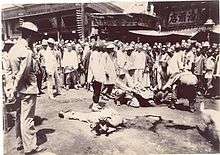Caishikou Execution Grounds
Caishikou Execution Grounds (traditional Chinese: 菜市口法場; simplified Chinese: 菜市口法场; pinyin: Càishìkǒu Fǎchǎng) was an important execution ground in Peking during the Qing Dynasty.

The execution ground was located at the crossroads of Xuanwumen Outer Street and Luomashi Street.[1] The exact location is under debate today. However, contemporary sources and photographs put it across from an apothecary shop named He Nian Tang (鶴年堂藥店).[2]
Executions were usually carried out at 11:30AM.[3] On the day of the execution, the convict would be carted from the jail cell to the execution grounds. The cart stopped at a wine shop named Broken Bowl (Chinese:破碗居) on the east side of Xuanwu Gate, where the convict would be offered a bowl of rice wine.[4] The bowl would be smashed after it was drunk. During the executions of infamous convicts, it was common for a large crowd to gather and watch. The torture death by a thousand cuts was also carried out at the execution ground.[5]
Famous people executed at Caishikou
- Zhu Yousong, or Hongguang Emperor, the first emperor of the Southern Ming Dynasty.
- Zhu Changfang, a member of the Royal family of Southern Ming Dynasty.
- Zheng Zhilong, father of Koxinga.
- Jahangir Khoja, East Turkic rebel leader.
- The Six gentlemen of the Hundred Days' Reform, including Tan Sitong and Lin Xu.
- Xu Jingcheng, Qing diplomat, during the Boxer Rebellion.
- Qixiu (啟秀), Manchu pro-Boxer official
See also
References
- Henriot, Christian; Yeh, Wen-hsin (2012). Visualising China, 1845-1965: Moving and Still Images in Historical Narratives. BRILL. p. 66. ISBN 978-9004233751.
- "解密北京菜市口秋決:犯人臨刑前吃大餅醬肘子".
- The time was 午時三刻 in old Chinese timekeeping, which corresponded to 11:30AM. "古代中國斬首行刑奇聞". Archived from the original on 20 August 2015.
- "Beijingers of the Past Seen in Photos (part three)". Archived from the original on 2016-03-04. Retrieved 23 Aug 2015.
- Chan, Shelley W. (2011). A Subversive Voice in China: The Fictional World of Mo Yan. Cambria Press. ISBN 978-1604977196.